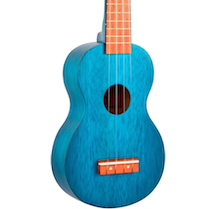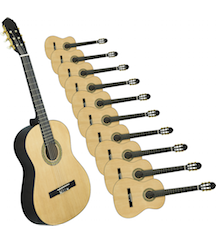
Making magic in the classroom with ukes and guitars
Guitars and ukuleles are enjoying great popularity in music education. They are wonderful instruments for introducing music fundamentals such as rhythm, scales, pitch and keys. Read on to understand why these instruments are good choices for young musicians and learn some ideas for incorporating them into your music curriculum.
Why are guitars and ukuleles good choices for young students?
These instruments are incredibly versatile allowing students to play melody, harmony and chords. Guitars and ukuleles can also be used for a wide variety of musical styles including classical, folk, jazz and other popular genres.
Both instruments are sturdy and are available in smaller sizes that are easier for young hands to manage. Virtually everyone has seen a guitar and a ukulele is similar; therefore, the instruments are immediately familiar and the concept of strumming is intuitive. Another reason these instruments are such good choices is their portability—a young student can easily carry them while walking or biking. A benefit for parents is the affordable price of these instruments.
Why ukes and guitars encourage students to play
Most educators who have taught guitar or ukulele in their classrooms have found that students have some success within very short time frames. The instruments are easy to handle compared to many others and the new player can produce notes immediately. Success fosters the desire to learn and with the ability to master familiar tunes and simple one finger chords, most students will enjoy playing. Additionally, there are many opportunities to play these instruments in extracurricular settings such as clubs or ensembles, and at home with family, encouraging students to practice and share what they have learned. In short, playing guitar or ukulele is fun!
What is a good age to start playing guitar or ukulele?
Experts generally agree that a child should around six years old to begin taking guitar or ukulele lessons. A child needs to have sufficient strength and dexterity to hold the instrument correctly and to simultaneously press down on the strings to create tones and chords. They also need to be able to follow instructions, stay focused and be motivated to learn.
 Tips for starting guitar and ukulele programs
Tips for starting guitar and ukulele programs
Identify some goals. As with any music program, set some goals that support your vision for the program. Are there school district goals that this new program might support?
Learn the instrument. Be sure you know how to play the guitar and/or ukulele yourself, because you will need to demonstrate techniques and be able to assist students with hand position and fingerings.
Research available resources that will help you design your curriculum. There are many available for guitar and an increasing number for ukulele, as it has become a very popular instrument.
Obtain instruments and accessories. You need ukuleles and/or guitars, but you’ll also need cases to protect them and tuners. Several major brands sell value packages that include all of these items, sometimes with special offers. If possible, supply each student in your largest class with their own ukulele, plus keep a few extra on hand in case one gets damaged. Stay away from instruments that cannot play in tune, don’t project well, or have flimsy tuning mechanisms. If your school cannot pay for the program in full, look into offsetting the cost with fundraisers or grants.
Reliable brands to consider include Mitchell and Mahalo for ukulele and Lyons, Rogue, and Yamaha for guitar. Some instruments, particularly ukuleles, come in different colors, a fun feature for younger students. Here are some excellent options:
Classroom ukuleles
- Mitchell MU40 Soprano Ukulele – a classroom 10-Pack
- Mahalo Kahiko Soprano Ukulele – comes in fun colors
- Diamond Head Soprano Ukulele – kids will love ‘em!
Classroom guitars
- Lyons Classroom Guitar – a trusted classroom brand
- Lyons Classroom Guitar Program Kit – a classroom pack - buy 10, get one free!
- Rogue Starter Acoustic Guitar – a great starter guitar
- Yamaha Classical Guitar – an affordable classic guitar
Get correctly sized instruments. If the guitar is too large for the child, playing will be frustrating. Guitars are typically measured by scale. Start with the size recommended for the child's age, but try the next size up if the child has larger hands or is taller than average.
- Get a 1/2 size guitar if the child is 6-9 years old
- Get a 3/4 size guitar if the child is 9-11 years old
- A full-size guitar is appropriate for children 12 years old or older
- Ukuleles are available in four : soprano, concert, tenor and baritone. The soprano is the most traditional and the best choice for beginner players.
Shopping for classroom ukuleles and guitars
Guitar and ukulele programs are providing young students with new choices for learning to play music. These easy to play, portable instruments are great alternatives that offer boundless opportunities for young players to explore their own creativity and passion for music.
If you need help shopping for the best ukes and guitars for your classroom, our school music experts are available to understand your needs and your budget. Call us at 800.346.4448 or shop at your convenience on the music educator website, where you’ll find everyday educator discounts.

 Tips for starting guitar and ukulele programs
Tips for starting guitar and ukulele programs
